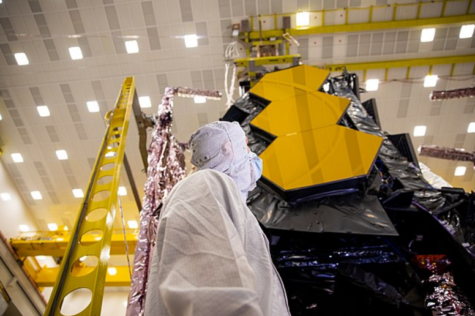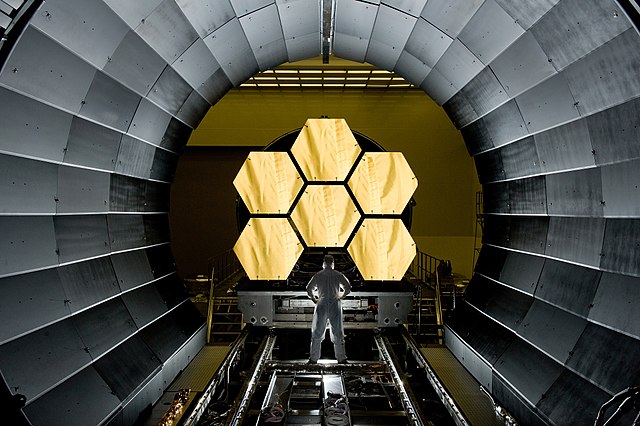NASA’s New James Webb Telescope is a Major Advancement in Space Exploration
The James Webb telescope will explore the universe in greater depth than any other previous spacecraft.
NASA/MSFC/David Higginbotham, Public domain, via Wikimedia Commons
The Webb telescope had to undergo numerous tests to ensure a successful launch. For example, cryogenic tests were used to make sure the most important parts of the telescope would hold up under the harsh conditions in space.
2021 was a magnificent year for space exploration. With groundbreaking discoveries ranging from water on Mars to a new type of supernova, scientists have gained more insight on the universe and potentially habitable planets.
At the center of all these discoveries is innovative technology. As we expand our presence farther into the universe, new technology is necessary to capture images we are unable to see from Earth.
One major telescope that was deployed in 2021 and is continuing its exploration through 2022 is the James Webb Space Telescope. Often referred to as just “Webb,” this telescope was created as part of a joint effort by NASA, the European Space Agency, and the Canadian Space Agency often referred to as Webb.
Launched from the Guiana Space Center in French Guiana, this $10 billion telescope includes a 6.5 meter long primary mirror covered in gold, which allows for the telescope to observe great amounts of infrared lights. “Having the ability to see into the infrared spectrum will allow it to uncover more details about the early universe, which we can use to unlock the mysteries of that very early time period,” said Luke Philips ’22, president of the Astronomy club at Bronx Science.
The telescope’s ability to observe infrared lights will also give it the ability to “look at star birth with greater precision through the dust of nebulas, and look at galaxies at their early developmental stages,” according to Farhan Naqib ’22. Webb will allow astronomers to see a part of our universe’s history that has not been seen before by previous telescopes. For Julianne Lee ’23, following the Webb Telescope project has made her hopeful that the telescope will answer many of the universe’s questions but it remains unknown what exactly it can find. “The ambition of the project makes exploration promising and opens many possibilities beyond cosmology and planetary science,” said Lee.

(Northrop Grumman / CC BY 2.0 <https://creativecommons.org/licenses/by/2.0>, via Wikimedia Commons)
The Hubble telescope, launched in 1990, is similar to the James Webb telescope, as it was also designed to help scientists understand the universe. However, Webb has a much larger mirror allowing it to see farther back in time than Hubble. “The Webb telescope is much more powerful than Hubble, which has already taught us so much, and there is still so much that we don’t know. It has been a while since we got an upgrade of this magnitude, so we are definitely going to learn a lot,” said Philips.
Although the telescope has great potential to grant us a deeper understanding of our universe, there have been some technical concerns regarding the possible risks of launching the telescope. Unlike the Hubble telescope, Webb was not designed to be repaired after being launched, so micrometeorites and space debris could jeopardize the whole mission.
However, many students still believe the telescope to be worth the danger. “Observatories on Earth have to deal with a constantly changing atmosphere; it’s like looking through a foggy lens. James Webb is going to be able to look at the skies in greater detail than ever before, with none of the restrictions that a telescope on the Earth’s surface has to deal with,” said Naqib.
The four main goals of the telescope include finding the first light in the universe, studying the formation of the earliest galaxies, learning more about the birth of stars, and understanding planetary systems. “These are all goals that can answer many questions in science. Not only that, but we never know what will come. Maybe something that we could never expect,” said Boris Khanikaev ’24.
Among the possible discoveries of Webb, the most anticipated ones are the discoveries concerning the beginnings of the universe and the formation of stars and galaxies. “I’m most excited about any potential discoveries related to the Big Bang. The period of time we know the least about is that first second of the universe, and I believe the James Webb telescope will bring us closer to an understanding,” said Philips.
“These moments are probably some of the most important ones that can answer questions about the early history of the universe,” said Naqib.
Webb has proven to be a crucial part of furthering our understanding of the universe. Knowing how our universe began is essential to knowing how it will impact our future, such as our future discovery of potentially habitable planets.
“Having the ability to see into the infrared spectrum will allow it to uncover more details about the early universe, which we can use to unlock the mysteries of that very early time period,” said Luke Philips ’22, president of the Astronomy Club at Bronx Science.
Grace Mao is a Managing Editor for 'The Science Survey,' where she edits her peers’ articles across various sections before they are published online....

